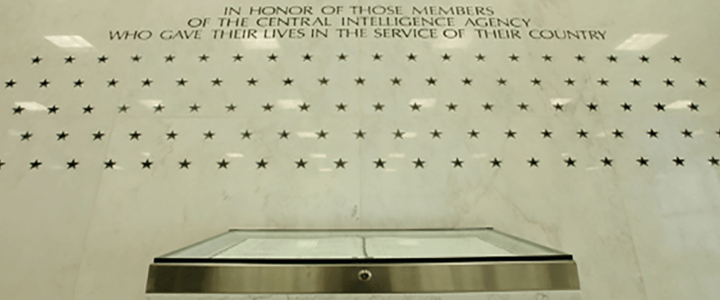Memorial Day is about remembering those who have died in service to the nation, traditionally adorning or decorating their graves with flowers. “Let no vandalism of avarice or neglect, no ravages of time, testify to the present or to the coming generations that we have forgotten, as a people, the cost of free and undivided republic,” said Union Army Maj. Gen. John A. Logan.
We tend to remember most prominently those who served in uniform. We should not forget those who operated quietly in the shadows and gave their life to “secure Blessings of Liberty to ourselves and our Posterity.” The Central Intelligence Agency’s Memorial Wall is a majestic, powerful, and reverent shrine to them.
QUIET TRIBUTE
Usually, memorials—in spite of their good intentions—mean bureaucracy. There’s lobbying, fund-raising, arguments over design . . . it goes on and on until, finally, something miraculously beautiful and moving is among us. Think about the Vietnam Memorial Wall, or the Korean War Memorial. We know the CIA is different. One day, almost as if stricken from on high, the CIA Memorial Wall, protected inside the CIA Headquarters, appeared: “There was no dedication ceremony, no pictures taken, and no fanfare. The stars and inscription simply appeared.” In truth, the Memorial Wall was the inspired work of Master Stone Carver Harold Vogel. Later, his apprentice, Tim Johnston would add stars, as well. But for the next 13 years after the wall appeared, nothing more was said. I suppose in the spirit of the CIA’s clandestine nature, nothing more needed to be said, and there’s something truly powerful and incredibly poignant in that 13 years of silence.
THE STARS
Originally adorned with 31 stars, today there are 125. The 125 stars in the constellation adorning the wall just inside CIA’s main entrance each represents a fallen CIA employee who died “while serving their country in the field of intelligence.” And the criteria for having a star added to the wall is quite specific and exclusive: “Death may occur in the foreign field or in the United States. Death must be of an inspirational or heroic character while in the performance of duty; or as the result of an act of terrorism while in the performance of duty; or as an act of premeditated violence targeted against an employee, motivated solely by that employee’s Agency affiliation; or in the performance of duty while serving in areas of hostilities or other exceptionally hazardous conditions where the death is a direct result of such hostilities or hazards.”
THE CEREMONY
It was 13 years before the CIA chose to gather around the wall for ceremony to publicly honor their dead. By the time the Agency held its first ceremony, 37 new stars had been added. At that first gathering in 1987, Deputy Director Robert M. Gates said a few words to a small, intimate group. Gates said, “Ceremonies that honor the dead are, in truth, for the living. They remind us of our mortality but also celebrate the lives and memories of those we have loved, trusted and respected.”
Over the years, little by little, the Agency opened the ceremony to a wider and wider audience. First, only family members of the fallen were invited. Today, others from outside the agency may be invite to attend. Still, it’s a remarkably reverent ceremony, modest and humble by D.C. standards of pomp and circumstance but filled with deep passion and devotion to mission, a sense captured in the words of Deputy Director John McLaughlin’s remarks in June 2001, shortly before the attacks of the following September. “The stars on the Memorial Wall are to us more than symbols, more than history. They are a priceless part of who we are. They are the colleagues and leaders who define us—in dedication and in sacrifice. It is in this new century their mission we seek to accomplish. And it is their commitment of which we seek to be worthy.”
You can read all about the CIA Memorial Wall in the Agency’s publication on the same.




